Product development happens every day in various businesses. Each has different approaches and processes they use to achieve project goals. Instead of focusing on features other companies impose, developing an impact mapping template tailored to your business is beneficial. It lets you focus on essential elements significantly impacting the company’s goals. Customizing the template allows you to align your strategies precisely with your unique objectives.
What is impact mapping?

Build Impact Mapping Template for Free
Impact mapping is a diagramming tool used when building projects or products. It allows teams to identify which features they must include in their product roadmap. This concept was first introduced in 2012 through a book called Impact Mapping: Making a Big Impact with Software Products and Projects, authored by Gojko Adzic, a software delivery consultant. Adzic discusses how the framework develops better plans in the book, ensuring the roadmap aligns with the business strategy.
As you use impact mapping, you’ll discover it differs from other feature planning approaches. It explains precisely and clearly why your team must include a particular feature in the roadmap. Everything you do indeed aligns with the company objectives and customer needs.
What should be included in the impact mapping template?
Your impact mapping template will have four essential components, and it’s vital to supply them with innovative insights accordingly.
- Goals.This falls on the first section or column of your impact mapping template. It’s essential to flesh out the core objective of the project or product. You can write it as precisely as possible, as the goal influences the entire direction of the project. It’s crucial to get this right from the start.
- Actors. This refers to any individual who plays a significant role in the business product's success or failure. Like your goals, identify the actors as specific as possible. Besides the customers, it’s also vital to determine other actors who will have a significant role in the project’s success. Also, you can include actors who might hinder the efficiency of your project.
- Impact. The third element on your impact mapping template will have insights about the roles your team wants every actor to fulfill to help you reach the project objective. You can take note of the desired behaviors you want to see, like completing tasks efficiently, recommending the product, or spending time on websites or apps.
- Deliverables.The last component of the impact mapping template will have features the identified actors will use to guarantee impacts. You can include in the final column the factors that let you use and incentivize the desired behavior more easily.
Impact Mapping Examples
Impact Mapping Example – 01
Nowadays, cybersecurity has become a priority in every organization. That’s why the first impact mapping example we are going to see is about a project that aims to enhance the cybersecurity of a company. In this instance, we can clearly see how the goal of strengthening the company’s infrastructure takes the form of numerous deliverables.
Therefore, the example will look like this:
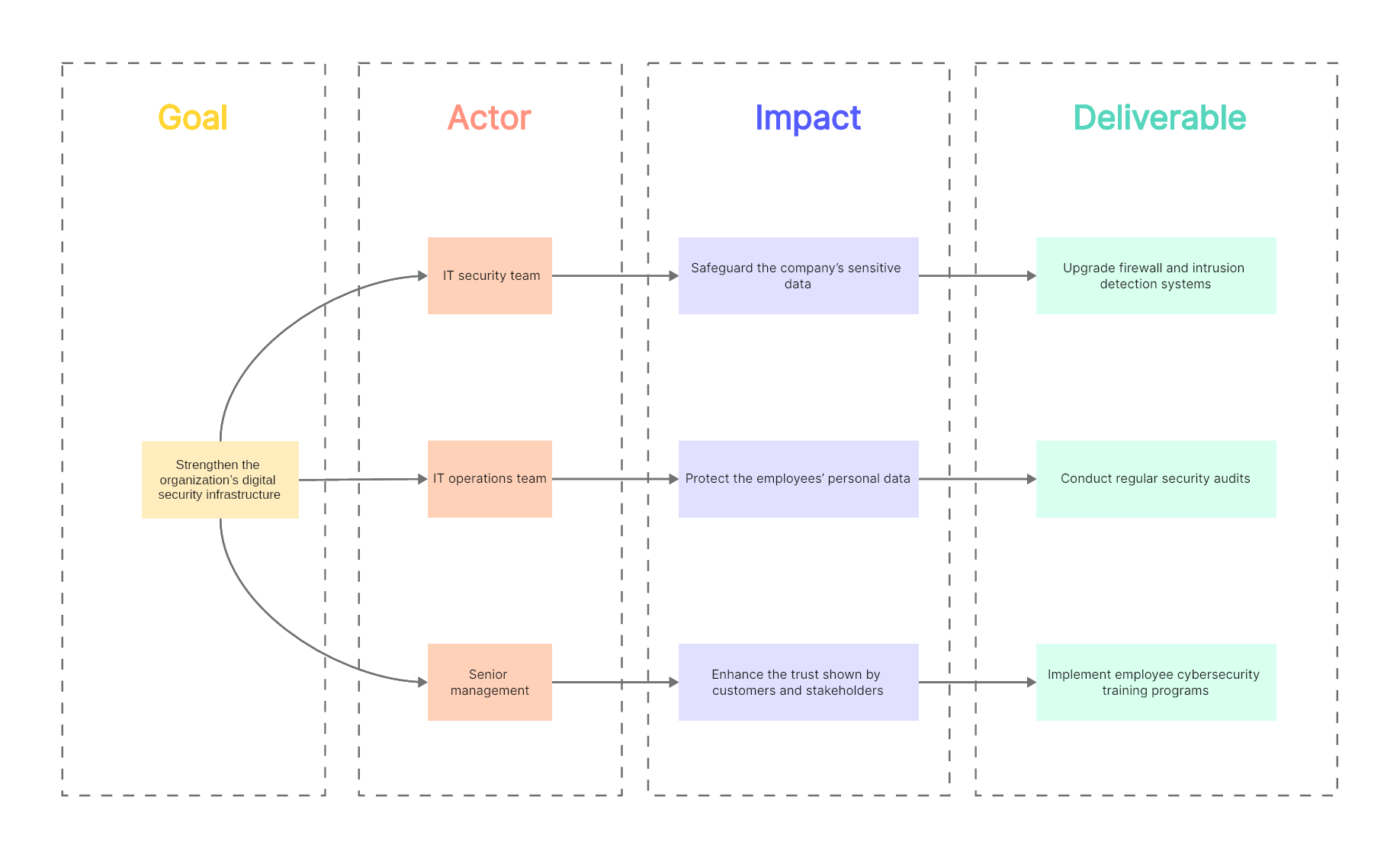
Build Impact Mapping Template for Free
- Goal: Strengthen the organization’s digital security infrastructure to prevent cyberattacks.
- Actors: IT security team, IT operations team, and senior management.
- Impact: Safeguard the company’s sensitive data, enhance the trust shown by customers and stakeholders, and protect the employees’ data.
- Deliverables: Upgrade firewall and intrusion detection systems, conduct regular security audits, and implement employee cybersecurity training programs.
Impact Mapping Example – 02
The following impact mapping example is a diagram of a rural entrepreneurship development program, implemented by a nonprofit organization. This program aims to give incentives to young entrepreneurs to move to a rural region to revitalize it.
This impact mapping diagram will be as follows:
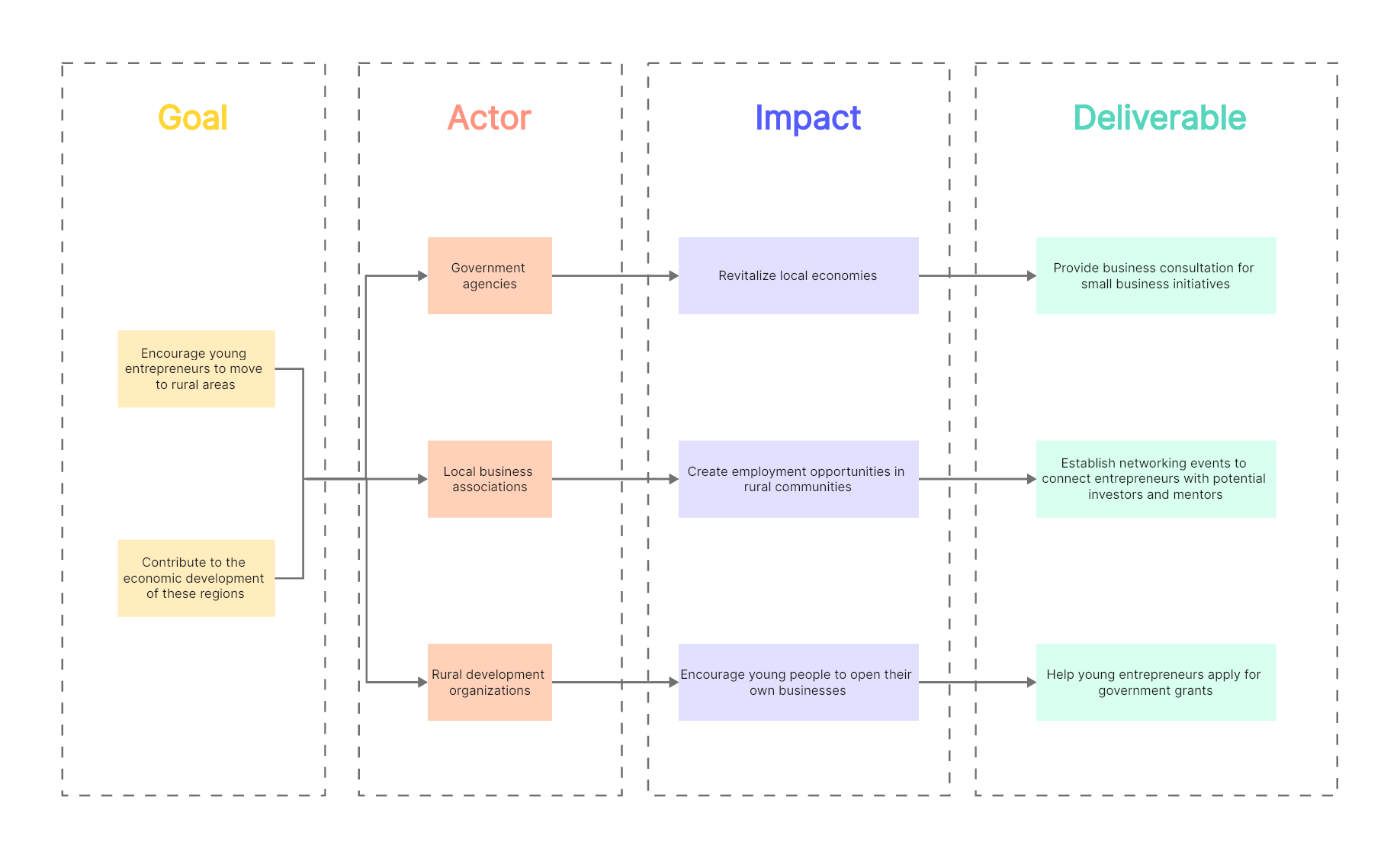
- Goal: Encourage young entrepreneurs to move to rural areas, and contribute to the economic development of these regions.
- Actors: Government agencies, local business associations, rural development organizations.
- Impact: Revitalize local economies, create employment opportunities in rural communities, and encourage young people to open their businesses.
- Deliverables: Provide business consultation for small business initiatives, offer business management training workshops, establish networking events to connect entrepreneurs with potential investors and mentors, and help young entrepreneurs apply for government grants.
Impact Mapping Example – 03
Another great impact mapping example is for a company that wants to become environmentally sustainable. Since more and more people are concerned about the sustainability of the businesses they associate with, this is something that every organization wants to implement.
In this case, the example will be this way:

- Goal: Minimize the organization’s carbon footprint.
- Actors: Sustainability team, operations team, and supply chain management.
- Impact: Foster a culture of environmental consciousness and contribute to a sustainable future.
- Deliverables: Shift to recyclable materials, use sustainable materials in the products’ packaging, and transit to renewable energy sources during the manufacturing process.
Impact Mapping Example – 04
In the next impact mapping example, we are going to analyze the development of a corporate training program. This particular example shows you the versatility of this tool as any department can use it for their projects.
This is how this example of impact mapping looks like:
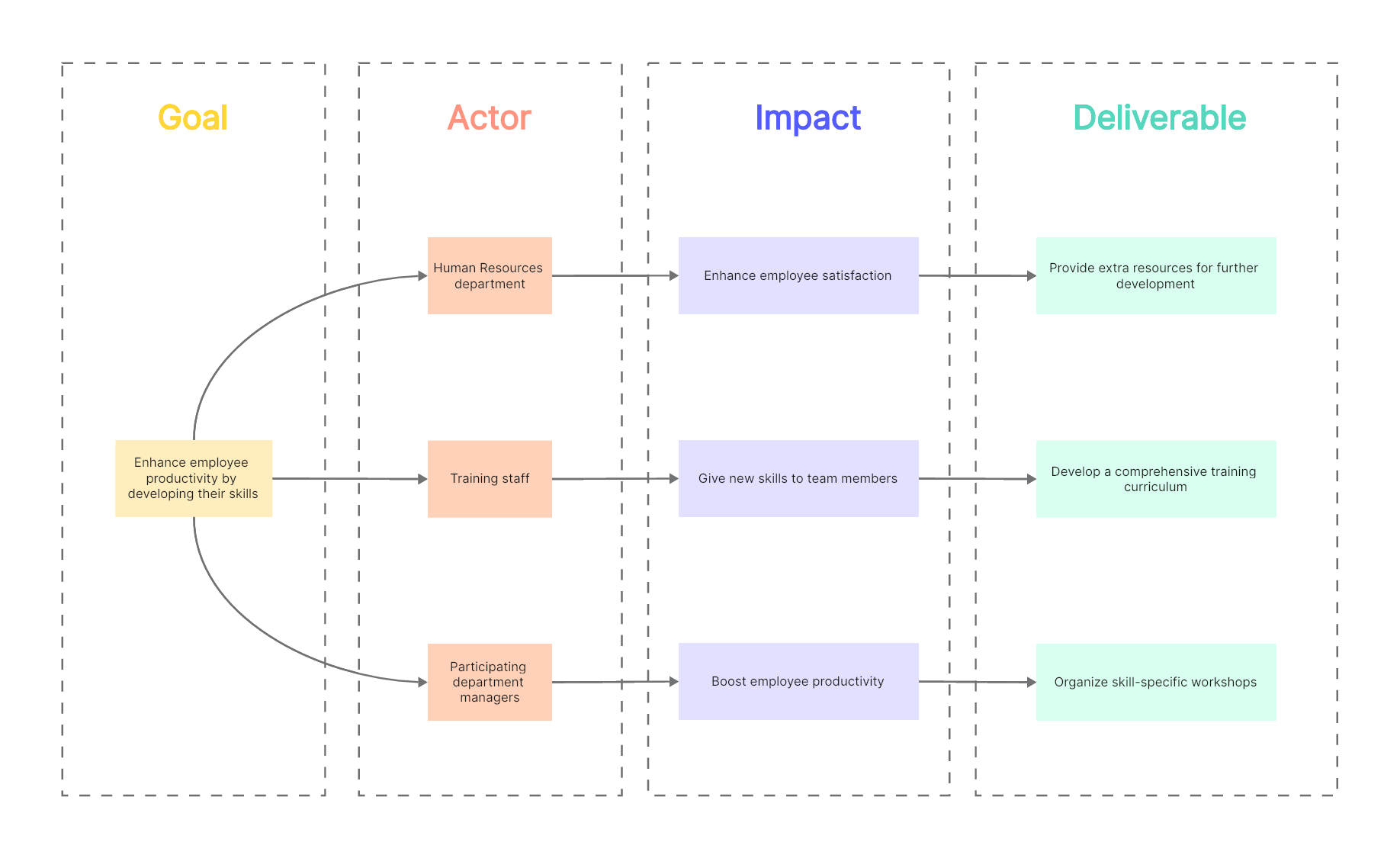
Build Impact Mapping Template for Free
- Goal: Enhance employee productivity by developing their skills.
- Actors: Human Resources department, training staff, and participating department managers.
- Impact: Boost employee productivity, enhance employee satisfaction, and give new skills to team members.
- Deliverables: Develop a comprehensive training curriculum, organize skill-specific workshops, and provide extra resources for further development.
How to write an impact mapping template?
The impact mapping template is straightforward but offers excellent returns when created accordingly. You can use Boardmix’s template library to choose among its diagrams in developing your template design. It’s customizable, so you can add colors and images and use tools on the workspace to edit the template.
Below are some helpful steps in writing the impact mapping template for your team.
- Decide on the goals. You either directly write your goals on the whiteboard or create a box containing the desired outcomes of the product or project.
- Identify your actors. Draw another box or column to write the actors. They’re responsible for producing the effect your team is aiming for. These actors can be users, customers, or those responsible for possible hurdles in your processes.
- Determine the actions or impacts. Ensure to record possible changes in the actor’s behavior due to the defined goal. It can also be fitting to list how they can help you reach your goals.
- Discuss the deliverables. Think about the project scope and initiatives to increase the probability of achieving your goals. For example, you’re developing a translation app that helps users understand Spanish. Your goal is to boost the app’s user activity. The impact you desire is for end users to access the app more often.
Remember that Boardmix lets you share your template immediately with team members through a unique link. You can allow access to the diagram from anywhere.
Create Impact Mapping Template in Boardmix:
Boardmix allows you to dig deeper into the world of impact mapping by providing you with a ready-made impact mapping template that you can use as a base for your project. Just select it from the template library and you will have an efficient impact mapping diagram in just a few clicks. Create your free account today to get started!
1. Create a New Board: Start by creating a new board in Boardmix. You can do this by clicking on "New Board" from your dashboard.
2. Choose a Template: If there's an existing Impact Mapping template available, you can choose that as your base. If not, you can start with a blank canvas.

3. Set Up Your Columns: An Impact Map typically consists of four columns or sections: Goals, Actors, Impacts, and Deliverables. Create these columns on your Boardmix board.
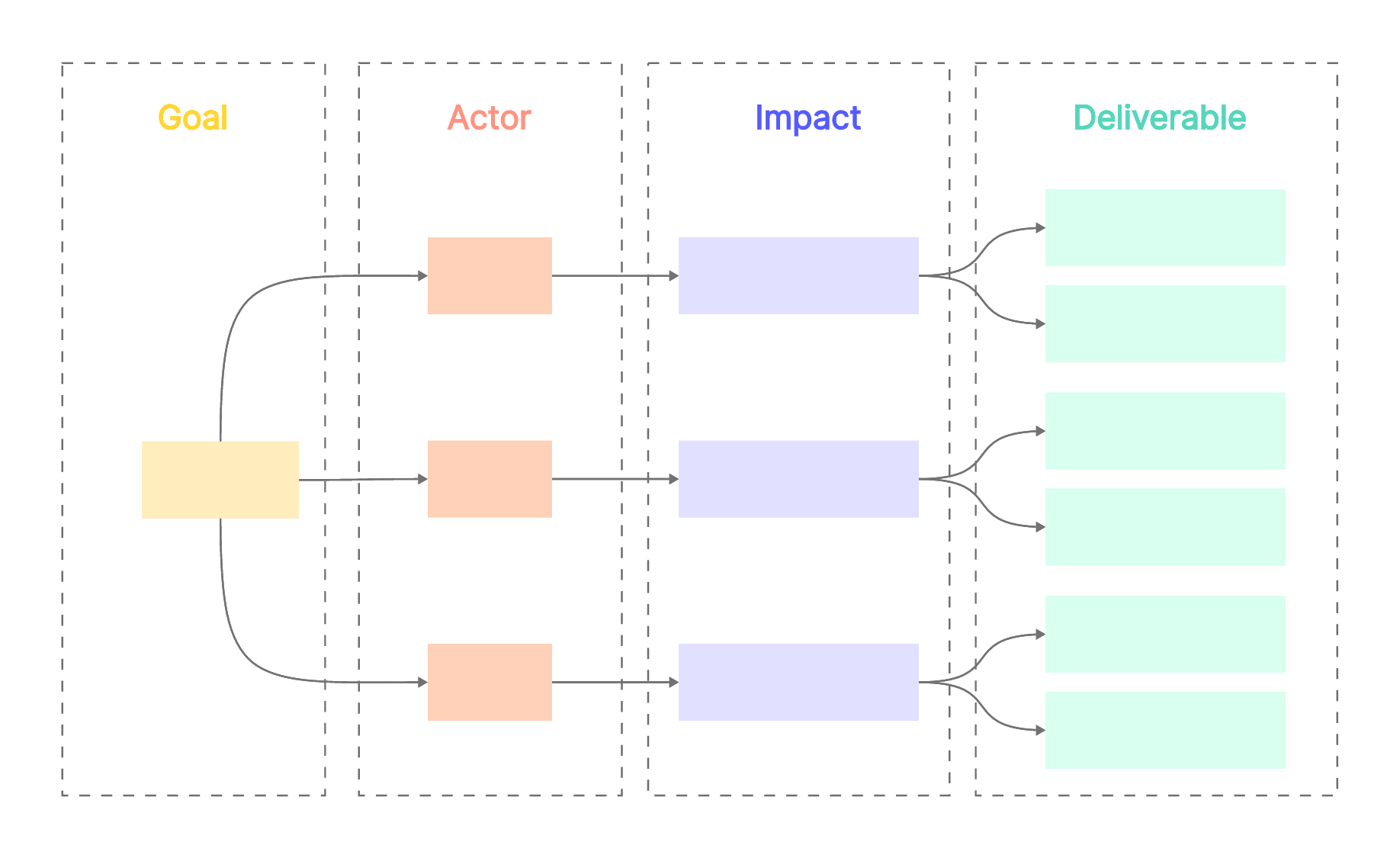
4. Add Cards: Within each column, you'll add cards representing different elements.
In the Goals column, define what you aim to achieve.
In the Actors column, identify who can influence the outcome of your goal.
In the Impacts column, list how these actors can help or hinder your goal.
In the Deliverables column, outline what tasks need to be completed to influence the actors' behaviors.
5. Customize Your Cards: You can customize each card with different colors, tags, or icons to make them more visually appealing and easier to understand.
6. Share Your Board: Once you've filled out your Impact Map, share it with your team members. They can add comments, suggest changes, or even add new cards as needed.
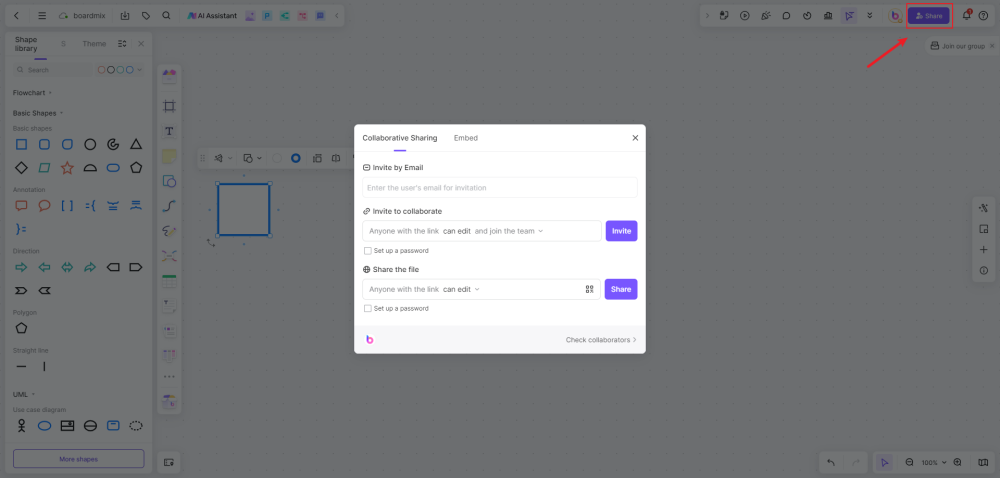
7. Update Regularly: As your project progresses and circumstances change, make sure to update your Impact Map accordingly.
FAQs about impact mapping
What is the purpose of impact mapping?
A well-structured impact mapping template serves multiple purposes.
- Strategic planning. The template is an excellent tool to engage technical experts and senior businesses as the company starts working on a project. It develops a shared understanding of the project scope, resulting in better collaboration. The framework also ensures that decision-makers and other stakeholders are aligned with the objective.
- Roadmap management. Impact mapping communicates priorities, goals, and scopes. In short, the template covers the necessary elements and processes in product development so teams can track if the project is gearing towards the desired result.
- Defining quality. The map is also an excellent visual tool showing the impacts technical deliverables are expected to produce. It keeps the delivery department focused and helps prioritize initiatives to ensure the product’s quality.






